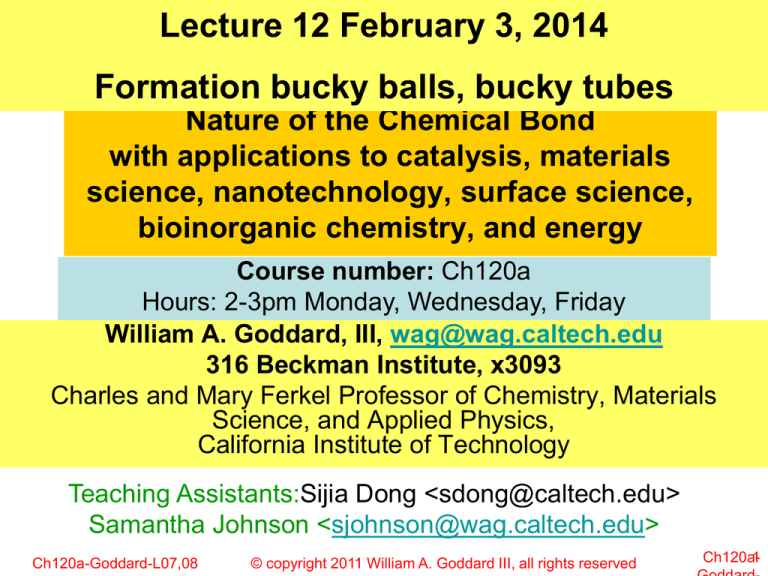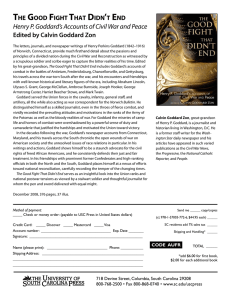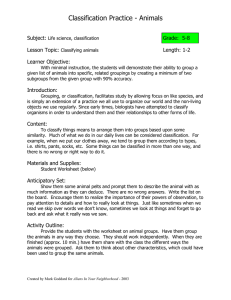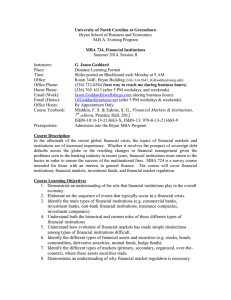
Lecture 12 February 3, 2014
Formation bucky balls, bucky tubes
Nature of the Chemical Bond
with applications to catalysis, materials
science, nanotechnology, surface science,
bioinorganic chemistry, and energy
Course number: Ch120a
Hours: 2-3pm Monday, Wednesday, Friday
William A. Goddard, III, wag@wag.caltech.edu
316 Beckman Institute, x3093
Charles and Mary Ferkel Professor of Chemistry, Materials
Science, and Applied Physics,
California Institute of Technology
Teaching Assistants:Sijia Dong <sdong@caltech.edu>
Samantha Johnson <sjohnson@wag.caltech.edu>
Ch120a-Goddard-L07,08
© copyright 2011 William A. Goddard III, all rights reserved
Ch120a1
C60 fullerene
No broken bonds
Just ~11.3 kcal/mol
strain at each atom
678 kcal/mol
Compare with 832
kcal/mol for flat sheet
Lower in energy than flat
sheet by 154 kcal/mol!
Ch120a-Goddard-L07,08
© copyright 2011 William A. Goddard III, all rights reserved
2
Polyyne
chain
precursors
Ch120a-Goddard-L07,08
fullerenes, all even
© copyright 2011 William A. Goddard III, all rights reserved
3
Ch120a-Goddard-L07,08
© copyright 2011 William A. Goddard III, all rights reserved
4
C540
All fullerens have 12
pentagonal rings
Ch120a-Goddard-L07,08
© copyright 2011 William A. Goddard III, all rights reserved
5
Mechanism for formation of fullerenes
Heath 1991: Fullerene road. Smaller fullerenes and C3 etc
add on to pentagonal sites to grow C60
Contradicted by He chromatography and high yield of
endohedrals
Smalley 1992: Pentagonal road. Graphtic sheets grow and
curl into fullerenes by incorporating pentagonal C3 etc add
on to pentagonal sites to grow C60
Contradicted by He chromatography
Arc environment: mechanism goes through atomic species
(isotope scrambling)
He chromatography Go through carbon rings and form
fullerenes
Has high temperature gradients
Ring growth road. Jarrold 1993. based on He chromatography
Ch120a-Goddard-L07,08
© copyright 2011 William A. Goddard III, all rights reserved
6
He chromatography (Jarrold)
Relative abundance of the isomers and
fragments as a function of injection
energy in ion drifting experiments
Conversion of bicyclic ring to fullerene
when heated
Ch120a-Goddard-L07,08
© copyright 2011 William A. Goddard III, all rights reserved
7
Energies from QM
Ch120a-Goddard-L07,08
© copyright 2011 William A. Goddard III, all rights reserved
8
Force Field for sp1 and sp2 carbon clusters
Ch120a-Goddard-L07,08
© copyright 2011 William A. Goddard III, all rights reserved
9
4n vs 4n+2 for Cn Rings
Ch120a-Goddard-L07,08
© copyright 2011 William A. Goddard III, all rights reserved
10
Population of various ring and fullerene species with Temperature
Based on free energies from QM and FF
Ch120a-Goddard-L07,08
© copyright 2011 William A. Goddard III, all rights reserved
11
Bring two C30 rings together
Ch120a-Goddard-L07,08
© copyright 2011 William A. Goddard III, all rights reserved
12
Energetics (eV) for isomerizations converting bicyclic ring to
monocyclic or Jarrold intermediates for n = 30, 40, 50
TS to Bergman cyclization
singlet (leads to Jarrold
ring
mechanism)
2 rings
TS to form tricyclic
E tricyclic
TS convert
C40
C34
E tricyclic
C60
Ch120a-Goddard-L07,08
© copyright 2011 William A. Goddard III, all rights reserved
13
Energetics (eV) for initial steps of Jarrold
Jarrold
pathway
If get here, then get
fullerene
Modified
Jarrold
Ch120a-Goddard-L07,08
Number pi bonds
© copyright 2011 William A. Goddard III, all rights reserved
14
energetics (eV)
Downhill race from tricyclic to bucky ball
30 eV of energy gain as
form Fullerene
Ch120a-Goddard-L07,08
Number
sp2
centers
© copyright
2011bonded
William A. Goddard
III, all rights reserved
15
Structures in Downhill race from tricyclic to bucky ball
Ch120a-Goddard-L07,08
© copyright 2011 William A. Goddard III, all rights reserved
16
energetics (eV)
Energy contributions to downhill race to fullerene
Number sp2 bonded centers
Ch120a-Goddard-L07,08
© copyright 2011 William A. Goddard III, all rights reserved
17
C60 dimer
Prefers packing of 6 fold face
De = 7.2 kcal/mol
Face-face=3.38A
Ch120a-Goddard-L07,08
© copyright 2011 William A. Goddard III, all rights reserved
18
Crystal structure C60
Expect closest packing: 6 neighbors in plane
3 neighbors above the plane and 3 below
But two ways
ABCABC face centered cubic
ABABAB hexagonal closet packed
Predicted crystal structure 3 months before experiment
Prediction of Fullerene Packing in C60 and C70 Crystals
Y. Guo, N. Karasawa, and W. A. Goddard III
Nature 351, 464 (1991)
Ch120a-Goddard-L07,08
© copyright 2011 William A. Goddard III, all rights reserved
19
C60 is face centered cubic
Ch120a-Goddard-L07,08
© copyright 2011 William A. Goddard III, all rights reserved
20
C70 is hexagonal closest packed
Ch120a-Goddard-L07,08
© copyright 2011 William A. Goddard III, all rights reserved
21
Vapor phase grown Carbon fiber,
R. T. K. Baker and P. S. Harris, in Chemistry and Physics of
Carbon, edited by P. L. Walker, Jr. and A. Thrower (Marcel
Dekker, New York, 1978), Vol. 14, pp. 83–165;
G. G. Tibbetts, Carbon 27, 745–747 (1989);
R. T. K.Baker, Carbon 27, 315–323 (1989).
M. Endo, Chemtech 18, 568–576 (1988).
Formed carbon fiber from 0.1 micron up
Xray showed that graphene planes are
oriented along axis but perpendicular to
the cylindrical normal
Ch120a-Goddard-L07,08
© copyright 2011 William A. Goddard III, all rights reserved
22
Multiwall nanotubes
"Helical microtubules of graphitic carbon". S. Iijima, Nature
(London) 354, 56–58 (1991).
Ebbesen, T. W.; Ajayan, P. M. (1992). "Large-scale synthesis of
carbon nanotubes". Nature 358: 220–222.
Outer diameter of MW NT
inner diameter of MW NT
Ch120a-Goddard-L07,08
© copyright 2011 William A. Goddard III, all rights reserved
23
Single wall carbon nanotubes, grown catalytically
S. Iijima and T. Ichihashi, "Single-shell carbon nanotubes of 1-nm
diameter".Nature (London) 363, 603–605 (1993) used Ni
D. S. Bethune, C.-H. Kiang, M. S. de Vries, G. Gorman, R. Savoy, J. Vazquez,
and R. Beyers, "Cobalt-catalyzed growth of carbon nanotubes with singleatomic-layer walls".Nature (London) 363, 605–607 (1993). used Co
Ching-Hwa Kiang grad student with wag on leave at IBM san Jose
Ch120a-Goddard-L07,08
© copyright 2011 William A. Goddard III, all rights reserved
24
Single wall carbon nanotubes, grown catalytically
S. Iijima and T. Ichihashi, "Single-shell carbon nanotubes of 1-nm
diameter".Nature (London) 363, 603–605 (1993) used Ni
D. S. Bethune, C.-H. Kiang, M. S. de Vries, G. Gorman, R. Savoy, J. Vazquez,
and R. Beyers, "Cobalt-catalyzed growth of carbon nanotubes with singleatomic-layer walls".Nature (London) 363, 605–607 (1993). used Co
Ching-Hwa Kiang grad student with wag on leave at IBM san Jose
Catalytic Synthesis of Single-Layer Carbon Nanotubes with a Wide Range of Diameters C.- H.
Kiang, W. A. Goddard III, R. Beyers, J. R. Salem, D. S. Bethune, J. Phys. Chem. 98, 6612–6618
(1994).
Catalytic Effects on Heavy Metals on the Growth of Carbon Nanotubes and Nanoparticles C.-H.
Kiang, W. A. Goddard III, R. Beyers, J. R. Salem, and D. S. Bethune, J. Phys. Chem. Solids 57, 35
(1995).
Effects of Catalyst Promoters on the Growth of Single-Layer Carbon Nanotubes; C.-H. Kiang, W. A.
Goddard III, R. Beyers, J. R. Salem, and D. S. Bethune, Mat. Res. Soc. Symp. Proc. 359, 69 (1995)
Carbon Nanotubes With Single-Layer Walls," Ching-Hwa Kiang, William A. Goddard III, Robert
Beyers and Donald S. Bethune, " Carbon 33, 903-914 (1995).
"Novel structures from arc-vaporized carbon and metals: Single-layer carbon nanotubes and
metallofullerenes," Kiang, C-H, van Loosdrecht, P.H.M., Beyers, R., Salem, J.R., and Bethune,
D.S., Goddard, W.A. III, Dorn, H.C., Burbank, P., and Stevenson, S., Surf. Rev. Lett. 3, 765-769
Ch120a-Goddard-L07,08
© copyright 2011 William A. Goddard III, all rights reserved
(1996).
25
Kiang CNT
form 1993
Ch120a-Goddard-L07,08
© copyright 2011 William A. Goddard III, all rights reserved
26
Kiang CNT form 1993
Ch120a-Goddard-L07,08
© copyright 2011 William A. Goddard III, all rights reserved
27
Distribution of
diameters for carbon
SWNT, Kiang 1993
Ch120a-Goddard-L07,08
© copyright 2011 William A. Goddard III, all rights reserved
28
Ch120a-Goddard-L07,08
© copyright 2011 William A. Goddard III, all rights reserved
29
Examples Single wall carbon nanotubes
Ch120a-Goddard-L07,08
© copyright 2011 William A. Goddard III, all rights reserved
30
Some bucky tubes
(8,8)
armchair
(14,0)
zig-zag
Ch120a-Goddard-L07,08
(6,10)
chiral
© copyright 2011 William A. Goddard III, all rights reserved
31
Contsruction for (6,10) edge
1
2
3
6
4
Ch120a-Goddard-L07,08
© copyright 2011 William A. Goddard III, all rights reserved
5
32
13.46A diameter
(10,10) armchair carbon
SWNT
40 atoms/repeat
distance
Ch120a-Goddard-L07,08
© copyright 2011 William A. Goddard III, all rights reserved
33
(14,0) zig-zag Bucky tube
Ch120a-Goddard-L07,08
© copyright 2011 William A. Goddard III, all rights reserved
34
Crystal packing
of (10,10) carbon
SWNT
13.5A
Density
SWNT: 1.33 g/cc
Graphite 2.27 g/cc
Ec Young’s modulus
SWNT 640 GPa
Graphite 1093 GPa
16,7A
Heat formation
Graphite 0
C60 11.4
Ch120a-Goddard-L07,08
(10,10)
CNT 2.72
Ea Young’s modulus
SWNT 5.2 GPa
Graphite 4.1 GPa
© copyright 2011 William A. Goddard III, all rights reserved
35
Vibrations in (10,10)
armchair CNT
Ch120a-Goddard-L07,08
© copyright 2011 William A. Goddard III, all rights reserved
36
Carbon fibers and tubes
Ch120a-Goddard-L07,08
© copyright 2011 William A. Goddard III, all rights reserved
37
Vibrations in (10,10)
armchair CNT
Ch120a-Goddard-L07,08
© copyright 2011 William A. Goddard III, all rights reserved
38
Vibrations in (10,10)
armchair CNT
Ch120a-Goddard-L07,08
© copyright 2011 William A. Goddard III, all rights reserved
39
Mechanism for gas phase CNT
formation
Polyyne Ring Nucleus Growth
Model for Single-Layer Carbon
Nanotubes
C-H. Kiang and W. A. Goddard III
Phys. Rev. Lett. 76, 2515 (1996)
Ch120a-Goddard-L07,08
© copyright 2011 William A. Goddard III, all rights reserved
40
Mechanism for gas phase CNT formation
A two-stage mechanism of bimetallic catalyzed growth of singlewalled carbon nanotubes Deng WQ, Xu X, Goddard WA
41
Nano Letters
42011
(12):
2331-2335
Ch120a-Goddard-L07,08
© copyright
William
A. Goddard III, all(2004)
rights reserved
But mechanism of gas phase C SWNT, no longer important
The formation of Carbon SWNT by CVD growth on
a metal nanodot on a support is now the preferred
mechanism for forming SWNT
Ch120a-Goddard-L07,08
© copyright 2011 William A. Goddard III, all rights reserved
42
Mechanisms Proposed for Nanotube Growth
Stepwise Process
Adsorption
Dehydrogenation
Saturation
Diffusion
Nucleation
Growth
Ch120a-Goddard-L07,08
© copyright 2011 William A. Goddard III, all rights reserved
43
Vapor-Liquid-Solid (Carbon Filament)
Mechanism
• Vapor carbon feed stock adsorbs unto
liquid catalyst particle and dissolves.
Dissolved carbon diffuses to a region of
lower solubility resulting in supersaturation and precipitation of the solid
product.
• Originally developed to explain the growth
of carbon whiskers/filaments.
• Temperature, concentration or free energy
gradient is implicated as the driving force
responsible for diffusion.
Wagner, R. S.; Ellis, W. C. Appl. Phys. Lett. 1964, 4, 89. Bolton, et al. J. Nanosci.
Nanotechnol. 2006, 6, 1211.
Ch120a-Goddard-L07,08
© copyright 2011 William A. Goddard III, all rights reserved
44
Yarmulke Mechanism
Dai, et al. Chem. Phys. Lett. 1996, 260, 471.
Raty, et al. Phys. Rev. Lett. 2005 95, 096103.
Ch120a-Goddard-L07,08
• Carbon-carbon bonds form
on the surface (either
before or as a result of
super-saturation).
• Diffusion of carbon to
graphene coating can be
an important rate limiting
step.
• Coating of more than a
complete hemisphere
results in poisoning of
catalyst.
• New layers can start
beneath the original layer
after/as it lifts off the
surface resulting in MWNT.
© copyright 2011 William A. Goddard III, all rights reserved
45
Experimental Confirmation of a Yarmulke
Mechanism
Atomic-scale, video-rate environmental transmission
microscopy has been used to monitor the nucleation and
growth of single walled nanotubes.
Hofmann, S. et al. Nano Lett. 2007, 7, 602.
Ch120a-Goddard-L07,08
© copyright 2011 William A. Goddard III, all rights reserved
46
Role of the Catalyst Particle in Nanotube
Formation
• Size of catalyst particles is related to the
diameter of the nanotubes formed.
• Catalyst nanoparticles are known to deform
(elongate) during nanotube growth.
• Structural properties of select catalyst
surfaces (Ni111, Co111, Fe1-10) exhibit
appropriate symmetry and distances to
overlap with graphene and allow thermally
forbidden C2 addition reaction.
• Graphene is believed to stabilize the high
energy nanoparticle surface. MWNT have
been observed growing out of steps, which
they stabilize.
•
•
•
Ch120a-Goddard-L07,08
Hong, S.; et al. Jpn J. Appl. Phys.
2002, 41, 6142.
Vinciguerra, V.; et al. Nanotechnol.
2003, 14, 655.
Hofmann, S. et al. Nano Lett.
2007, 7, 602
© copyright 2011 William A. Goddard III, all rights reserved
47
Tip vs. Base Growth Mechanisms
Same initial reaction step: absorbtion,
diffusion and precipitation of carbon
species.
Strength of interaction between catalyst
particle and catalyst support determines
whether particles remains on surface or
is lifted with growing nanotube.
Huang, S.; et al. Nano Lett. 2004 4, 1025.
Kong, J.; et al. Chem. Phys. Lett. 1998, 292, 567.
Ch120a-Goddard-L07,08
Images of nanotubes show catalyst
particles trapped at the ends of
nanotubes in the case of tip growth, or
nanotubes bound to catalysts on
support in the case of base growth.
Alternatively capped nanotube tops
show base growth.
A kite (tip) growth mechanism has been
used to explain the growth of long (order
48
of mm),
well III,
ordered
SWNTs.
© copyright 2011 William
A. Goddard
all rights reserved
Limiting Steps for Growth Rates
Diffusion of reactive species either
through the catalyst particle bulk or across
its surface can play an important role in
determining the rate of nanotube growth.
In the case of carbon species which
dissociate less readily the rate of carbon
supply to the particle can act as the rate
limiting step.
The rate of growth must also take into
account a force balance between the
friction of the nanotube moving through
the surrounding feedstock gas and the
driving force for/from the reaction.
Vinciguerra, V.; et al. Nanotechnol. 2003, 14, 655.
Hofmann, S. et al. Nano Lett. 2007, 7, 602.
Hafner, J. H.; et al. Chem. Phys. Lett. 1998, 296, 195.
Ch120a-Goddard-L07,08
© copyright 2011 William A. Goddard III, all rights reserved
49




